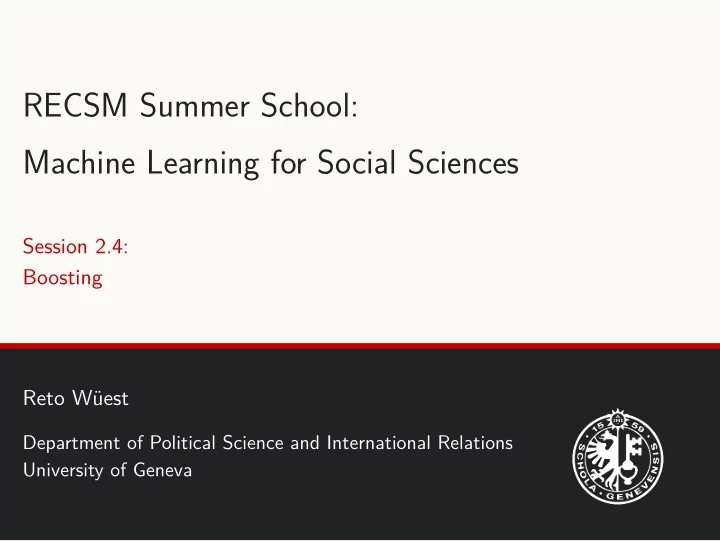

RECSM Summer School: Machine Learning for Social Sciences Session 2.4: Boosting Reto Wüest Department of Political Science and International Relations University of Geneva 1
Boosting
Boosting • Like bagging, boosting is a general approach that can be applied to many machine learning methods for regression or classification. • Recall that bagging creates multiple bootstrap training sets from the original training set, fits a separate tree to each bootstrap training set, and then combines all trees to create a single prediction. • This means that each tree is built on a bootstrap sample, independent of the other trees. 1
Boosting • In boosting, the trees are grown sequentially: each tree is grown using information from previously grown trees. • Boosting does not involve bootstrap sampling. Instead, each tree is fit on a modified version of the original data set. 2
Boosting Algorithm
Boosting Algorithm: Boosting for Regression Trees 1 Set ˆ f ( x ) = 0 and r i = y i for all i in the training set. 2 For b = 1 , 2 , . . . , B , repeat: f b with d splits ( d + 1 terminal nodes) to the (a) Fit a tree ˆ training data ( X, r ) . (b) Update ˆ f by adding in a shrunken version of the new tree f ( x ) ← ˆ ˆ f ( x ) + λ ˆ f b ( x ) . (2.4.1) (c) Update the residuals r i ← r i − λ ˆ f b ( x i ) . (2.4.2) 3 Output the boosted model B ˆ λ ˆ � f b ( x ) . f ( x ) = (2.4.3) b =1 3
Boosting What Is the Idea Behind Boosting?
What Is the Idea Behind Boosting? • Unlike fitting a single large decision tree, which potentially overfits the data, boosting learns slowly. • Given the current model, we fit a new decision tree to the residuals from that model (rather than the outcome Y ). • We then add the new decision tree into the fitted function in order to update the residuals. 4
What Is the Idea Behind Boosting? • Each of the trees can be rather small, with just a few terminal nodes, determined by parameter d . • Fitting small trees to the residuals means that we slowly improve ˆ f in areas where it does not perform well. • The shrinkage parameter λ slows the process even further, allowing more and different shaped trees to attack the residuals. 5
Boosting Tuning Parameters for Boosting
Tuning Parameters for Boosting 1 Number of trees B • Boosting can overfit if B is too large. • Use CV to select B . 2 Shrinkage parameter λ • Controls the rate at which boosting learns. • A small positive number, typical values are 0.01 or 0.001. • Very small λ can require a very large value of B in order to achieve good performance. 6
Tuning Parameters for Boosting 3 Number of splits in each tree d • Controls the complexity of the boosted ensemble. • It is the interaction depth, since d splits can involve at most d variables. • Often d = 1 works well, in which case each tree is a stump (consisting of a single split). 7
Boosting – Gene Expression Example Boosting and Random Forests Applied to Gene Expression Data 0.25 Boosting: depth=1 Boosting: depth=2 RandomForest: m= p 0.20 Test Classification Error 0.15 0.10 0.05 0 1000 2000 3000 4000 5000 Number of Trees (Boosting with stumps, if enough of them are included, outperforms the depth-two model. Both boosting models outperform a random forest. Source: James et al. 2013, 324) For the two boosted models, λ = 0 . 01 . Note that the test error rate for a single tree is 24% . 8
Recommend
More recommend